CHAIN BREAKERS:
15 repetitions
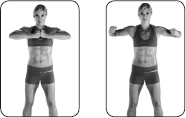
KNEE-UPS:
60 reps, alternating
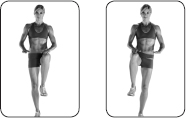
JUMPING JACKS:
60 reps
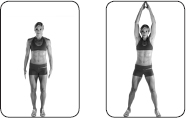
SHOULDER CROSSOVERS:
30 reps
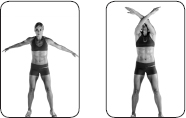
HEAD ROLLS:
15 reps
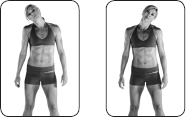
Everyone is always asking me about the best way to work out to get thin, fit, and toned. They are searching for a magical and easier way to exercise, grasping on to every fad in every magazine. Well, you might be surprised to find out that, yes, there is an ideal, special way to work out that will give you the body you want: Power Circuits. You’ll learn how to do them in this chapter.
I’m sure you’ve heard of “circuit training.” Just about everyone has. Circuit training combines the principles of aerobic conditioning and weight lifting to help you burn calories while building strength. It’s a popular workout for the time-deprived, and it never gets boring. With circuit training, you work through a series, or circuit, of exercises, completing one right after the other with very little rest between sets. You get the best of both worlds, perfectly combining resistance training (muscle tone/fast metabolism) with cardiovascular activity (calorie loss). The continuous nature of circuit training gives you a major calorie burn. Because there’s no rest between sets, you finish your workout in thirty minutes. Further, you can change the exercises in your circuit whenever you want, so there’s less chance of falling into an exercise rut.
* More burn. Circuit training simultaneously improves mobility, strength, and stamina and is the best way to burn calories in the fastest time—period! This type of exercising has been shown by research to burn more calories in a shorter period of time than conventional exercise routines, thus decreasing body fat. Conventional weight lifting burns 200 to 250 calories an hour, whereas circuit training burns anywhere from 350 to 550. That’s a lot more burn for your buck!
* More tone. Circuit training really tightens and shapes your body. Because many muscles are engaged while circuit training, more toning occurs and more calorie burning occurs.
* More smile. People who do conventional weight training often miss out on the “runner’s high”—that surge of naturally produced endorphins that comes from running, cycling, swimming, and other forms of intense cardio. Endorphins do amazing things: They relieve pain, they reduce stress, they enhance the immune system, and they postpone the aging process. So not only will you look good on the outside, but thanks to circuit training you’ll feel good on the inside, too.
All my clients have different goals: Some are getting in shape for the red carpet; others want to make a life change. But one thing they all have in common: They want to lose weight fast—which is why I use my own brand of circuit training called Power Circuits.
Power Circuits are an amped-up version of basic circuit training. You work out harder and faster. It’s a constant flow of motion, almost like rowing a boat where you never let the oars stop moving. In addition, Power Circuits alternate between upper- and lower-body exercises, so you don’t waste time waiting for all muscle groups to recuperate. With Power Circuits, you’re always focusing on large muscle groups like your chest, back, glutes, core, hamstrings, and quadriceps, since they burn the most amount of fat. If you’ve been working out for a while, but aren’t seeing the results you want or have reached a seemingly permanent plateau, Power Circuits will kick-start your body back into results mode.
With my Power Circuits, there’s a formula I use to ensure results. I call it my 3-F Formula. This means you combine two functions (two exercises) with perfect form and do the exercises to complete fatigue. And by “fatigue,” I mean don’t stop till you drop!
I always have my clients work the same muscle group with two different exercises right in a row for more efficient fat burning and a leaner body. An example would be to perform a dumbbell chest press with perfect form until you can barely lift another rep; then you’d quickly do push-ups until you can’t press yourself up again. Because you have already fatigued your chest with the dumbbell presses, you’ll be able to only do eight to ten push-ups, so it all goes very fast. Muscles respond extremely well to this formula. It’s great for reshaping your body fast.
With my Power Circuits, you always want to get the fullest benefits from your workouts as you can. Besides using my 3-F Formula, follow these intensity principles and you’ll be on your way to creating a shapely, defined body.
By alternating upper- and lower-body exercises, your body is being constantly challenged in a way that helps burn more calories and more fat—plus keeps your metabolism high. While giving your upper body a rest, you work your lower body, and vice versa. This produces twice the results.
When you do use weights, don’t be a wimp. A lot of people make the mistake of using very light weights. They think that more reps will help burn calories and body fat, but in reality this is an ineffective way to train. You’ve got to use a resistance heavy enough that your muscles are on fire for the last five to eight reps in your set. Muscle tissue burns fat—and the best way to build muscle is by lifting heavier with great form. By adding 5 to 10 percent more resistance to your moves and performing sets in the fifteen- to thirty-rep range, you shock your metabolism to burn even faster. This kind of intensity burns six hundred extra calories in the two days following your workout!
After one month of working out, you will hit a plateau and discover that no matter what you do you’re not getting the results you want. This typically happens if you have been following the same routine for a while, exercising your muscle groups in the same pattern or sequence and not increasing your poundages or repetitions. Muscles get bored and, after some time, their tissues don’t regenerate the way they did at the start of your workout phase. One of the best ways of breaking out of a plateau is to jack up the intensity of your workouts. You can do this by increasing your poundages, reps, or changing up your exercises once a month. The same goes for cardio too. You’ve got to up your speed, duration, and resistance once a month.
You don’t need two hours in the gym every day to achieve a rock-hard body. The people who spend that much time in the gym are usually athletes or hanging out and socializing. All you need is a thirty-minute resistance training workout, preceded by a twenty-minute interval cardio workout, as I outlined in chapter 8. Stay focused and work intensely. If you’re not burning and sweating, then you’re not using correct form or enough weight.
Doing the same thing over and over, hoping for a different result, is called insanity! Change your program so that your body keeps changing. Being stuck and not making progress is known as plateauing, and you want to avoid it at all costs. Fortunately, you have a number of Power Circuits to choose from, right here in this chapter. So after about a month, to keep making progress, switch to another Power Circuit routine and increase your resistance. This will give your body new challenges and compel it to change in the direction of the goals you’ve set.
The less rest time, the more human growth hormone (HGH) your body releases through exercise. And as I’ve said, HGH signals the body to build muscle and burn fat. Minimizing rest between sets also pumps more fat-burning oxygen through your system.
My trainers always tell their clients: Don’t think about it, just do it. And guess what? They get results. The concept of don’t think, do intrigued me, so I decided to research the truth behind it. I learned that successful exercisers really don’t think about having to train, they just get out and do it. Sandra Cousins, EdD, an exercise gerontologist at the University of Alberta in Edmonton, has studied this phenomenon herself. She found that people who relied on self pep talks to try to motivate themselves remained couch potatoes, because they actually talked themselves out of exercising! The lesson here: The more you talk about it, the more exhausted and stressed out you might get about it. Find that fire and go!
Keep a training log and have your routine planned out before you start. I always pre-write my routines because it makes me accountable. If I know I’m expected to do my legs routine because it’s written out, I’m more likely to follow through. Also, it’s an absolute must to track your reps, sets, and increases with resistance training. Over time, your written log will help you identify strengths, weaknesses, and improvements in your physique. Seeing your progress on paper is incredibly motivating. You’ll be encouraged and inspired when you look back on your entries and see how far you’ve come.
In your training log, be sure to note any significant feelings, mental or physical, that occur in response to working out. If I’m not sore after my back routine, for example, I make a note of this. This feedback tells me I need to change weight or exercise groupings. On the other hand, put a smiley face next to the days when working out made you feel sore. Soreness means great things are happening to your muscles. Keeping tabs on your progress (or lack thereof) is the only way to accurately assess your progress, stay accountable, and devise solutions to problems. I still carry my battered little training log to the gym every day. I’ve provided a sample training log for you in appendix C.
Grab a cloth tape measure and take your before measurements now and your after measurements a month from now. The best areas to measure are:
* Your chest: Across the middle of your breasts. Keep the tape measure level around your body.
* Your waist: Around your belly button.
* Hips: Around the widest part of your hip area.
* Thighs: Around the largest part of both thighs.
* Biceps: Flex and measure around the largest part.
In the chart below, record your weight and measurements.
| MY MEASUREMENTS | |
| BEFORE Date: | AFTER Date: |
| Chest: | Chest: |
| Waist: | Waist: |
| Hips: | Hips: |
| Right Thigh: | Right Thigh: |
| Left Thigh: | Left Thigh: |
| Right Biceps: | Right Biceps: |
| Left Biceps: | Left Biceps: |
When taking these measurements, do it at an appropriate time, like in the morning. For example, you wouldn’t want to take your waist measurement after you eat a treat meal.
After a month, get the tape measure out again and get excited about your changing shape. You might have lost inches all over. You may have gained inches in a good way. Instead of a flat butt, you may have developed a tighter, higher butt. The overall shape of your body will change with more muscle and less fat. Your clothes should fit differently in one month’s time.
I came up with this phrase to combat my total frustration at seeing constant ab machine infomercials and prominent trainers peddling ab exercise balls on TV and promising weight loss and a six-pack. Doing hundreds of crunches on any contraption won’t help you lose weight. It’s a total disservice to the public when professionals sell that concept to you. The only muscles that help you burn fat are the large muscles of the body, such as quadriceps or pectorals. This means that a push-up, because it works your chest, is a better fat burner and core builder. I’m not saying that training your abs isn’t important; it’s just that many ab exercises like crunches aren’t going to make you thinner. Also, if you focus only on crunches, you won’t lose weight from your belly, and you may build some muscle under your fat—which will make your waistline larger! So doing endless crunches is a waste of time.
An effective way to trim inches from your midsection, in addition to doing large-muscle core work, is to do two to three ab exercises at the end of your Power Circuit routine. Also, change the combination of those exercises each time to keep those muscles challenged. Another tip to burn ab fat is to contract your abdominal muscles while doing any kind of cardiovascular exercise like Spinning or running. Diet changes such as reducing alcohol consumption or cutting out refined sugar during the week will really burn off belly fat and allow your six-pack to emerge.
Okay—it’s time to start my fat-burning, boredom-busting, attitude-enhancing program. Look at your calendar and figure out when you can truly allot fifty minutes, three days a week, to this program. Your fifty-minute workout will include a twenty-minute interval cardio and your thirty-minute resistance-training routine.
We all have an optimal strength period in which our body is more energized and stronger. If you know you’re too tired after work, for example, don’t even try to work out. Schedule a morning time, and keep the appointment. That way, you’re setting yourself up for success. You’ll feel amazing accomplishment throughout the day by getting it done and doing it at a time compatible with your body’s energy level.
CHAIN BREAKERS: 15 repetitions |
 |
KNEE-UPS: 60 reps, alternating |
 |
JUMPING JACKS: 60 reps |
 |
SHOULDER CROSSOVERS: 30 reps |
 |
HEAD ROLLS: 15 reps |
 |
Completion of one full routine is the equivalent of one set. Each routine should be performed three times straight through in order of exercises.
Routine A
Choose weights heavy enough so that when performing a set it’s difficult to squeeze out the last five reps and still maintain good form. After one month, be sure to change up your routine to prevent a plateau. Increase your poundages, your reps, or both.
CIRCUIT 1
DUMBBELL PRESSES WITH TWIST: 15 reps/3 sets |
 |
DUMBBELL FLYES: 15 reps/3 sets |
 |
UFCS: 30 reps/3 sets/no weight |
 |
|
15 reps each leg/3 sets/no weight |
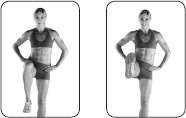 |
HEADBANGERS: 15 reps/3 sets |
 |
NARROW PRESSES: 15 reps/3 sets |
 |
V-TUCKS: 30 reps/3 sets/no weight |

|
BICYCLE: 30 reps/3 sets/no weight |

|
DUMBBELL HAMMER PRESSES : 15 reps/3 sets |
 |
REVERSE DUMBBELL PRESSES: 15 reps/3 sets |
 |
SISSY SQUATS: 15 reps each leg/3 sets |
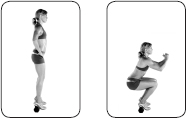
|
FRONT DUMBBELL LUNGES: 15 reps each leg/3 sets |
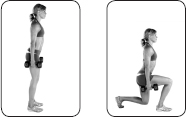 |
KICKBACKS: 15 reps/3 sets |
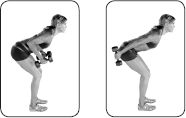 |
NOSE BUSTERS: 15 reps/3 sets |
 |
AB HOLDS: 30 reps/3 sets |
 |
WINDSHIELD WIPERS: 30 reps/3 sets |
 |
RENEGADE PUSH-UPS: 30 reps/3 sets |
 |
DUMBBELL FLYES: 15 reps/3 sets |
 |
UFCS: 30 reps/3 sets |
 |
JUMP SQUATS: 15–30 reps/3 sets |
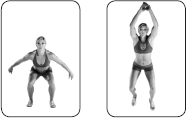 |
NARROW PRESSES: 15 reps/3 sets |
 |
|
15–30 reps/3 sets |
 |
DUMBBELL TRANSVERSES: 30 reps/3 sets |
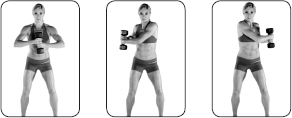 |
SINGLE-LEG JACKKNIVES: 15 reps each side/3 sets |
 |
Choose weights heavy enough so that when performing a set it’s difficult to squeeze out the last five reps and still maintain good form. After one month, be sure to change up your routine to prevent a plateau. Increase your poundages, your reps, or both.
CIRCUIT 1
WIDE DUMBBELL PULLS: 15 reps/3 sets |
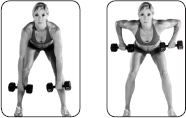 |
WINGMANS: 30 reps/3 sets |
 |
DUMBBELL DEAD LIFTS: 15 reps/3 sets |
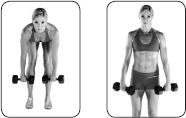 |
CROSS-KNEE BRIDGES: 15–30 reps/3 sets |
 |
CONCENTRATION CURLS 15 reps/3 sets |
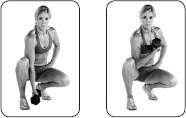 |
ALTERNATING DUMBBELL CURLS WITH ROTATION: 15 reps/3 sets |
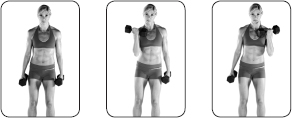 |
V-TUCKS: 30 reps/3 sets/no weight |
 |
BICYCLE: 30 reps/3 sets/no weight |
 |
CIRCUIT 2
ALTERNATING DUMBBELL ROWS: 15 reps/3 sets |
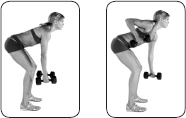 |
|
30 reps/3 sets |
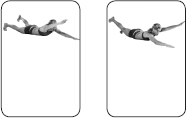 |
ALTERNATE SPLIT JUMPS: 30 reps/3 sets |
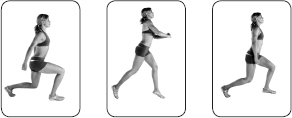 |
CROSS-KNEE BRIDGES: 15–30 reps/3 sets |
 |
OUTER CURLS: 15 reps/3 sets |
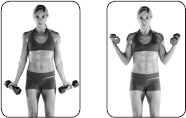 |
|
15 reps/3 sets |
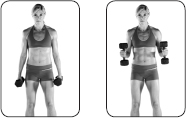 |
AB HOLDS: 30 reps/3 sets |
 |
WINDSHIELD WIPERS: 30 reps/3 sets |
 |
CIRCUIT 3
WIDE DUMBBELL PULLS: 15 reps/3 sets |
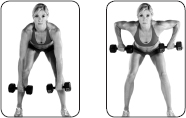 |
DUMBBELL PULLOVERS: 15 reps/3 sets |
 |
DUMBBELL DEAD LIFTS: 15 reps/3 sets |
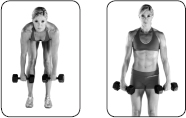 |
REVERSE PLANKS: 15–30 reps/3 sets |
 |
ALTERNATING DUMBBELL CURLS WITH ROTATION: 15 reps/3 sets |
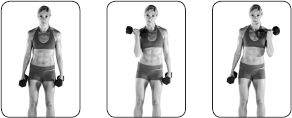 |
REVERSE CURLS: 15 reps/3 sets |
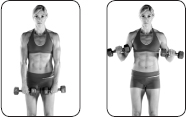
|
DUMBBELL TRANSVERSES: 30 reps/3 sets |
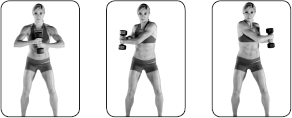 |
SINGLE-LEG JACKKNIVES: 15 reps each side/3 sets |
 |
Routine C
Choose weights heavy enough so that when performing a set it’s difficult to squeeze out the last five reps and still maintain good form. After one month, be sure to change up your routine to prevent a plateau. Increase your poundages, your reps, or both.
CIRCUIT 1
DUMBBELL FRONT SQUATS: 15 reps/3 sets |
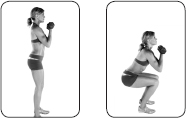 |
BACK BRIDGES: 15–30 reps/3 sets |
 |
INS AND OUTS: 15 reps/3 sets |
 |
DUMBBELL LATERAL RAISES: 15 reps/3 sets |
 |
V-TUCKS: 30 reps/3 sets |
 |
BICYCLE: 30 reps/3 sets |
 |
CIRCUIT 2
HEISMANS: 30 reps each side/3 sets |
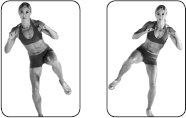 |
|
15–30 reps/3 sets |
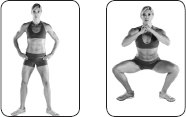 |
FRONT RAISES: 15 reps/3 sets |
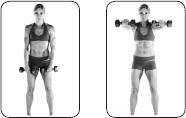 |
BENTOVER REAR FLYES: 15 reps/3 sets |
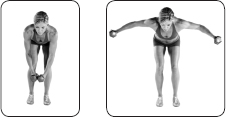 |
AB HOLDS: 30 reps/3 sets |
 |
WINDSHIELD WIPERS: 30 reps/3 sets |
 |
DUMBBELL FRONT SQUATS: 15 reps/3 sets |
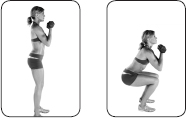 |
DONKEY-KICK CROSSOVERS: 30 reps/3 sets both legs |
 |
DUMBBELL LATERAL RAISES: 15 reps/3 sets |
 |
INS AND OUTS: 15 reps/3 sets |
 |
DUMBBELL TRANSVERSES: 30 reps/3 sets |
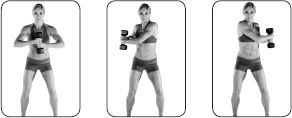 |
|
15 reps each side/3 sets |
 |
The Cool-Down
HURDLER’S STRETCH: Hold each stretch 30 seconds. |
 |
SUMO STRETCH: Hold each stretch 30 seconds. |
 |
KNEE CROSSOVERS: Hold each stretch 30 seconds. |
 |
CHEST STRETCH: Hold each stretch 30 seconds. |
 |
|
Hold each stretch 30 seconds. |
 |
CHILD’S POSE: Hold each stretch 30 seconds. |
 |
TRICEPS STRETCH: Hold each stretch 30 seconds. |
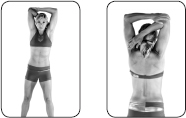 |
Do your twenty-minute cardio interval work five times a week. Ideally, three of those workouts should be done prior to your resistance-training routine, as I noted above. You can, however, do your cardio apart from the resistance training, on different days or at different times during the day. Regardless of how you organize your workouts, the key is to do five 20-minute interval cardio routines every week.
I always tell clients, “If the muscle doesn’t burn, it’s not working. So make it burn!” The same goes for soreness. If the muscle isn’t sore one to two days following your workout, then it’s not working. Muscle soreness is a sign of muscle progress. If you’re sore after exercising, that’s positive. Sore muscles equal toned muscles. That said, if you feel excessively sore following a workout, and you’re uncomfortable, do the following:
* Make sure you’re supplementing with free-form amino acids daily. They’ll help your muscles repair more quickly.
* Mix two tablespoons of baking soda into thirty-two ounces of the water you’ll drink daily. Baking soda neutralizes the lactic acid buildup in muscles that causes the soreness.
When you eat and what you eat before and after exercising can maximize your results. Here are my guidelines on eating to help better develop your muscles and have more energy for your workouts.
If you’ve had a balanced meal within the last three hours, you shouldn’t need to eat anything before hitting the gym. But if it’s been longer than three hours since your last meal, or you’re working out first thing in the morning, make yourself a protein shake prior to working out. I blend one every morning.
Otherwise, have a light snack about an hour prior to exercising. It should be high in protein. I eat boiled eggs prior to training, for example. Other good pre-workout snacks include nuts, peanut butter on toast, or a cup of oatmeal. Don’t grab any sweets or other source of refined sugar, looking for quick energy. Your body won’t burn as much fat.
Consider what happens inside your body as a consequence of intense exercise: Energy-giving glycogen stores are depleted. Muscle protein is dismantled. Microscopic tears in muscle fibers occur, and muscles are inflamed. You never want to “eat” into that fat-burning muscle, so you must supply your body with good nutrition. About an hour after your workout, eat a healthy meal with the right combination of protein, carbs, and fat, like those meals listed in appendix A. If you can’t get a full meal in, make sure to have a snack. Some ideal post-workout snacks include:
* Slice of whole-grain or gluten-free bread with turkey breast slices (add desired veggies and mustard)
* Piece of fresh fruit and low-fat cheese
* Handful of raw nuts such as almonds and a piece of fresh fruit
* A whey protein shake blended with half a banana or a cup of fresh berries
* Hummus on whole wheat pita bread
* Tuna drizzled with a little lemon juice and olive oil spread over a slice of whole wheat or gluten-free bread
* Cup of oatmeal
* Grilled chicken and a cup of brown rice
* Low-fat cottage cheese and a piece of fresh fruit
This perfect combo of diet and exercise is going to shock your system in the best way! So get excited and get ready to see real, lasting results.